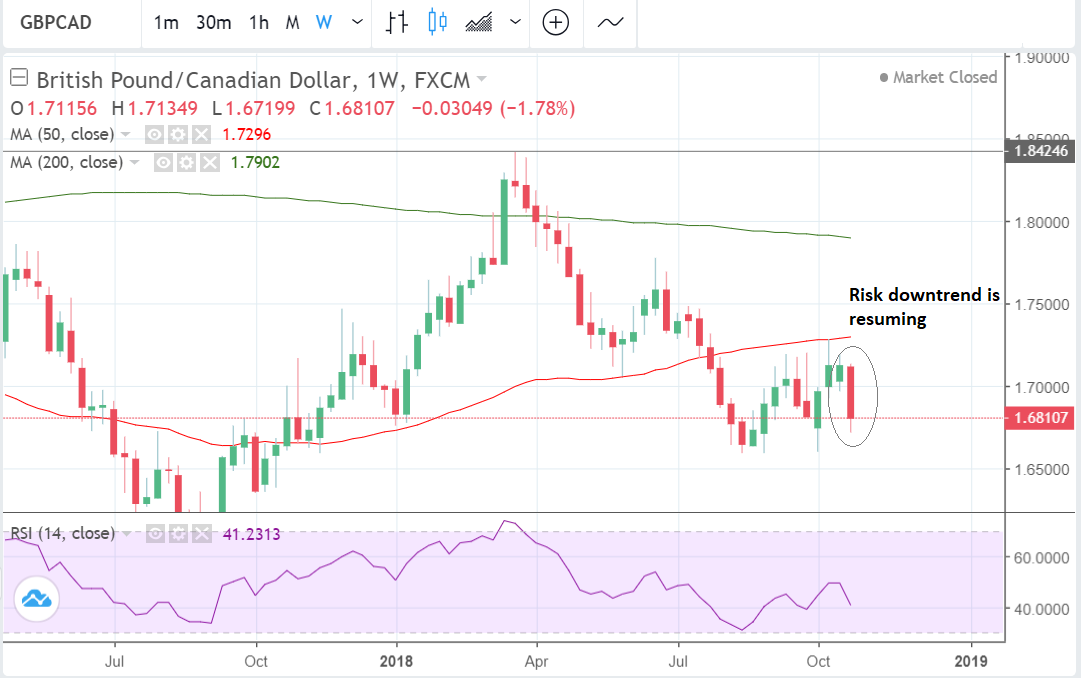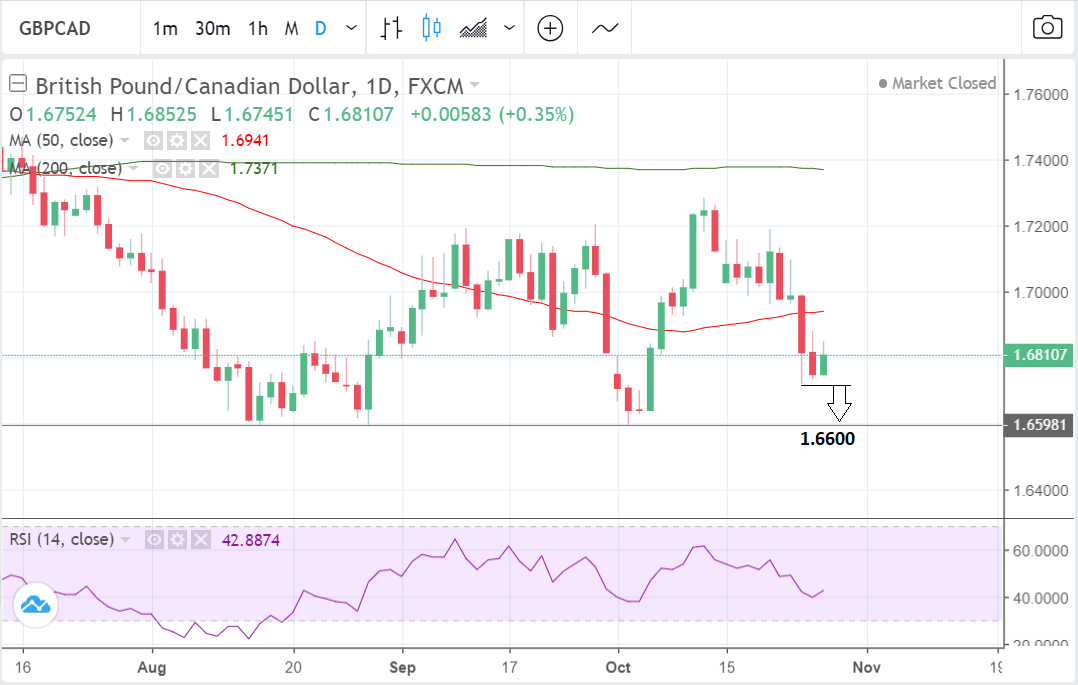Pound-to-Canadian-Dollar Rate 5-Day Forecast: Downtrend Resumes

Image © Adobe Stock
- Downtrend to resum this week.
- The 1.66 low now in the cross-hairs.
- GBP eyes BoE, labour data up for CAD.
The Pound-to-Canadian-Dollar exchange rate fell last week as a breakdown in the Brexit negotiations and a hawkish message from the Bank of Canada (BoC) conspired to push the exchange rate lower.
The Pound went from buying $1.7116 at the start of the week to $1.6810 by Friday, representing a loss of almost three cents. There is a risk that the broader downtrend in force since March now resumes.

Above: Pound-to-Canadian-Dollar rate shown at weekly intervals.
Fundamentals certainly seem to suggest this could be the case.
The contrast between Canada, which recently negotiated a trade deal with the U.S. and Mexico, and the U.K. which is still in the process of negotiating with the EU, couldn't be starker.
We think the bias is for more downside in the week ahead.

Above: Pound-to-Canadian-Dollar rate shown at daily intervals.
The daily chart shows a range-bound picture with the pair having oscillated broadly between 1.72 and 1.66 ever since the August lows.
GBP/CAD has been falling within that range and is likely to continue until it reaches the 1.66 floor.
A break below the 1.6720 lows would probably green-light a continuation down to the target at 1.66. Further weakness would then be conditional on a break below 1.6560, to the October 2017 lows of 1.6375.
Advertisement
Bank-beating GBP/CAD exchange rates: Get up to 5% more foreign exchange by using a specialist provider to get closer to the real market rate and avoid the gaping spreads charged by your bank when providing currency. Learn more here
The Pound: What to Watch
The budget statement on Monday at 13.30 is an event that could impact the Pound during the week ahead.
Economic growth forecasts and government spending plans will have an impact on both bond and currency markets but we are told that Chancellor Philip Hammond will likely play a neutral hand as he awaits the outcome to Brexit negotiations before delivering a fundamental shift in direction.
The impact on Sterling is likely to be neutral.
The main in the week ahead for the Pound is the Bank of England (BOE) interest rate announcement and quarterly inflation report, due on Thursday, 01 November at 13:00.
The BoE is not expected to change its interest rate so markets will focus on the contents of the inflation report and commentary from governor Mark Carney in order to gauge when the bank's next likely move on interest rates will come.
If the BoE's forecasts still show inflation remaining above its target in 2021 then Sterling may find support because markets would infer that the bank remains on course to keep raising interest rates over coming quarters.
Inflation rose to 2.7% in August, from 2.4%, when markets had looked for it to rise to only 2.5%. The recent rise in wages could also factor in the the BoE's forecasts, as that also supports expectations of higher inflation ahead.
Brexit remains the great unknown that might prevent the BoE from revealing its hand too much but assuming the government can agree to a transition period after March, the BOE is likely to raise interest rates again in May 2019 according to ING Group.
"If a majority of MPs approve the agreement in the Parliamentary vote (despite all the current bluster), then the UK will leave the EU on time in March and the transition phase will commence. This somewhat smoother outcome would keep the door open to a May rate hike," says James Knightley, an economist at ING.
Analysts at broker XM.com say the BOE will probably use Thursday's meeting to reiterate its forward guidance for 1-2 rate hikes per year over the next few years.
"It’s less probable that the BoE will modify its guidance of 1-2 rate increases per year over the next few years. The pound could firm slightly if Governor Mark Carney stresses in his press conference that the risks to inflation remain to the upside," says XM.com.
UK Manufacturing and Construction PMI's are also due out in the week ahead, with both likely to impact expectations for fourth-quarter economic growth. The manufacturing PMI is expected to fall to 53.0 for October, from 53.8 previously. The construction PMI is seen declining from 52.1 to 52.0.
The Canadian Dollar: What to Watch
The main release in the week ahead for the Canadian Dollar is employment data for October, which is forecast to show a 10k increase in the number of jobs created by the economy during the recent month at 13.30 London time on Friday.
The unemployment rate is expected to remain at 5.9%. Last month's labour data were not as good as the headline number suggested because the 63k rise in total jobs masked a shift toward part-time work.
A rise in full-time workers for October would be positive for the Canadian Dollar. Higher employment tends to lead to higher wages and higher inflation. This, in turn, leads to higher interest rates, which are positive for a currency.
August GDP data is scheduled for release on Wednesday at 13.30. GDP rose 0.2% previously and at an annualized rate of 2.4%. Stronger growth could be very positive for the Canadian Dollar.
Advertisement
Bank-beating exchange rates! Get up to 5% more foreign exchange by using a specialist provider to get closer to the real market rate and avoid the gaping spreads charged by your bank when providing currency. Learn more here









